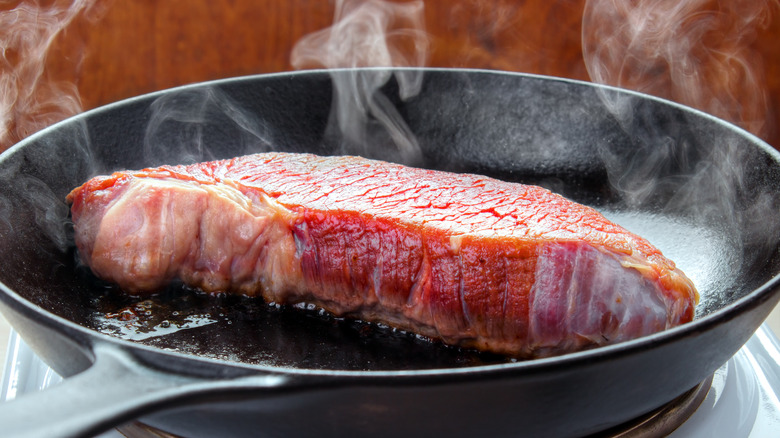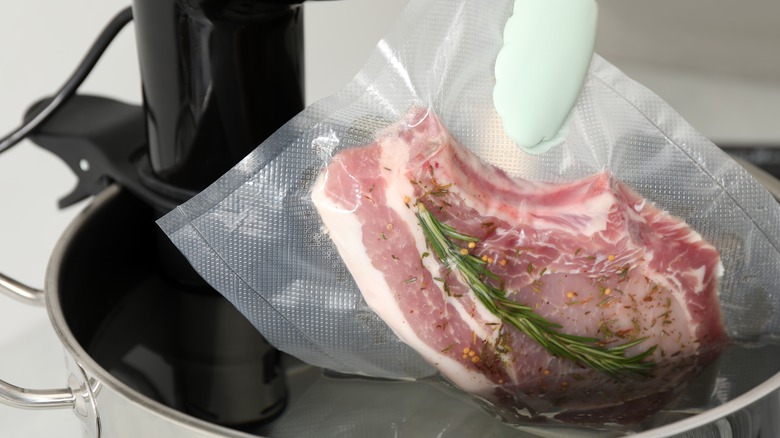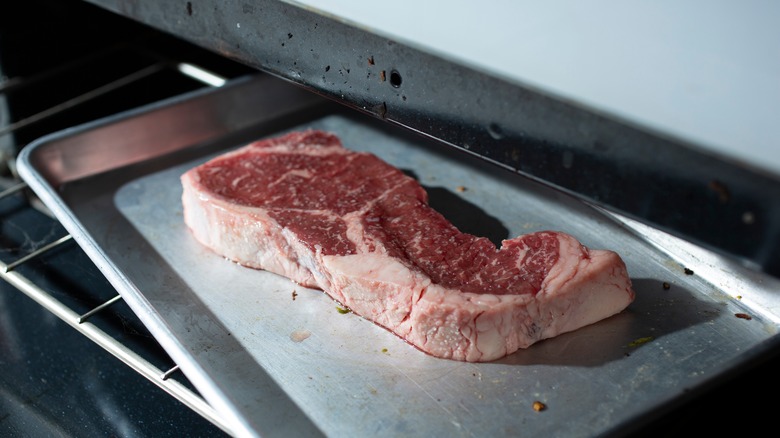The Expert Cooking Technique That's Perfect For Large Cuts Of Steak
Ready to level up your steak game? Do as the pros do: bring your steak up to temperature before you blast it with heat. It's not your grandpa's technique, but the modern method makes it easy for amateurs to make crispy, succulent, evenly-cooked steaks. For advice, we turned to Matthew Kreider, the Cordon Bleu-trained executive chef at Miami's Steak 954.
"For a thick steak like a large ribeye, you can use sous vide, tempering, or reverse sear," says Kreider. His go-to method is sous vide: "I typically sous vide at 110 degrees Fahrenheit for about 30 minutes, depending on the size of the steak." Tempering is simply a word for resting the meat at room temperature before cooking; a necessary, low-effort step. It won't provide the same results as sous vide or a reverse sear, though. Both techniques involve slowly cooking the meat to just below the right internal temperature, then finishing it on an ultra-hot pan or grill. Unlike traditional methods, you don't risk overcooking the meat while you wait for it to cook through.
If you're not willing to shell out for a specialized sous vide machine, you might prefer a reverse sear. The technique mimics sous vide in a standard oven. Feeling creative? Our writers have used a dishwasher as a sous vide machine and reverse seared a steak in an air fryer. But for those of you who want to stick to more conventional methods, Kreider has advice.
How to sous vide steak
Sous vide, French for "under vacuum", is a technique where food is vacuum sealed in a plastic bag and slowly cooked in a water bath. The bath is heated by a sous vide machine, also called an immersion circulator. The machine circulates the water around the tub and keeps it at a precise temperature. Sous vide takes time, but the results are worth it. The biggest benefit? The precise temperature control. According to Kreider, his recommended 30 minutes at 110 degrees Fahrenheit "will never cook [the meat] past rare." He adds, "You can add herbs and salt while it's cooking. Then finish it on a hot grill or a screaming hot pan and enjoy!"
As always, rest your meat after searing — but Kreider recommends cutting the rest time short. "With the sous vide technique the resting time decreases as well, as it is a much more gentle cooking process." The exact rest time will depend on the cut of meat.
Sous vide machines are great for low-effort meal prep, too — not just fancy steaks. But that doesn't mean that they're right for everyone. Lower-end models start at around $100, and the machines aren't very useful for people who rarely eat meat. Not sure if you're ready to commit? Try reverse sear and see how you like the results.
How to reverse sear steak
Despite the fact that reverse searing is decidedly low-tech, it only dates back to the early '00s; not long after sous vide took the culinary world by storm. At the time, sous vide machines were too expensive for home cooks, so innovative foodies came up with their own technique. Kreider recommends using a reverse sear for large cuts: "You can reverse sear larger cuts of steak," he says. "Large strips, ribeyes, chateaubriand will all do well."
For a reverse sear, heat your oven to anywhere between 200 to 275 degrees Fahrenheit. Place your steak on a wire rack with a rimmed baking sheet underneath to catch drips. Regularly check the steak with a thermometer and take it out when it's about 15 degrees shy of the right temperature. Going for a 130 degree Fahrenheit medium rare steak? Take it out at 115 degrees. Generally, it'll take about 20 or 30 minutes to reach the right temperature — but the exact time depends on the cut. Once the meat is ready, Kreider says to "Blast it in either a hot pan or a preheated broiler." Adding, "Don't forget to rest!"
So why buy a sous vide machine if reverse searing gives similar results? "I think reverse searing takes more practice and attention than using sous vide," Kreider explains. "Make sure to have a thermometer with an alarm you can use in the oven."


